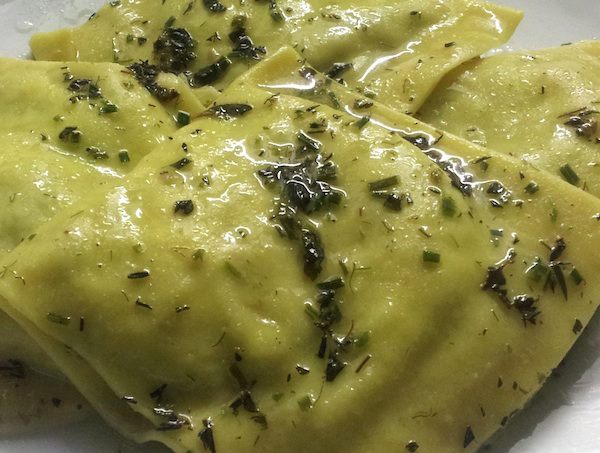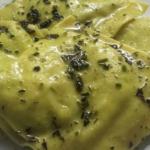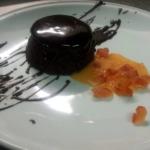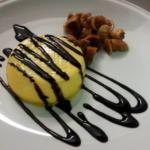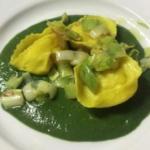A few steps away from Piazza del Popolo, in a sober and welcoming atmosphere, Arancia Blu is a restaurant specialized in vegetarian and vegan cuisine with a rich and varied menu, as well as a broad selection of wines.

Arancia blu also promotes cultural events, through an open minded project called “bistro-library” which has already proposed guided tours to important exhibitions held in the capital.
I am greeted by the chef Fabio Bassan, to whom I ask the reasons for going vegetarian.
F.B. As a consequence of a personal lifestyle choice, I had the idea of creating a vegetarian restaurant that offers tasty and “non-punitive” dishes: I wanted to show that it is possible to eat in a good, balanced and stimulating way even not using meat and fish.
What motivated your personal choice to become a vegetarian?
F.B. Basically it was an ethical inclination, the respect for animals; consequently, having to start a business like this, I decided to use my imagination and creativity to convey to others such choice, starting from the traditional Italian cooking: one that opts for “poor” ingredients but at the same time is very varied, making use mainly of fruits, vegetables, beans, and what could be picked up in the garden, the woods and the meadows.
There is another special feature at Arancia blu, that is to start cooking from raw materials only and offer exclusively home-made dishes, including pasta and desserts; among other things, a very challenging choice for a restaurant, but you dared to do it.
F.B. This allows us to control all stages of the process, from the choice of carefully selected ingredients; fortunately, I must say that in Italy there are many suppliers offering raw materials of the highest quality; moreover, I find that being in a city helps in this sense, because it allows you to find everything you want, thanks to distributors as well.
What do you look for in a raw material, how do you judge its quality?
F.B. The parameters of quality are numerous, I seek in particular ingredients that are persistent, focused, noticeable even in small doses, but manageable in the preparation of dishes. Before buying I usually request samples to be tested; it is a meticulous and careful search, suppliers and distributors are very helpful from this point of view.
What room is there for organic food in your kitchen? And how easy or difficult is it for a restaurant to use organic ingredients?
F.B. We use a lot of fresh fruits and vegetables and do not always manage to find them organically grown in enough quantities and with continuity, so we happen to integrate with others. We also also work directly with farmers who, despite not being certified, have “natural” products and often decide not to opt for organic certification because of the cost and complications involved. We tend to use seasonal produces, which have their reason to exist anyway and that we evaluate directly.
Even in our wine list there is a selection of certified organic and biodynamic labels, and natural wines.
Within your menu, what would you suggest as a must-try dishes?
F.B. Surely the homemade pasta, bronze drawn and hand-worked; then the homemade desserts; and yet all the recipes with ingredients expressing the Italian regional excellence, such as pistachios, hazelnuts, almond paste, among the best things in the world.
In Italy, every region offers excellent products, as highlighted by Slow Food; just think of all the varieties of garlic and onion… for instance, talking about onions, a whole world opens up: from that of Tropea to the less known “cipolla di Cannara”, and then the flat round, the golden round, the giant Sicilian “cipolla di Giarratana”, as big as a watermelon (from 500g up to 2kg ed.)
It is within everyone’s reach to discover these products, just take a book or look for Slow Food “presidia”, such research could allow Italy to be a rich country (I speak not only about excellence of food, but that’s another story) .
What do you think about sprouts, how do you use them in your kitchen?
F.B. Sprouts are experiencing a second youth, after a decline perhaps due to the difficulty in finding them. From a nutritional point of view they are very healthy, they contain the essence of the plant, it is amazing to imagine that something so small holds all the strength of the plant, just think of a pine nut that can turn into a pine! It’s exceptional and we note it especially when watching sprouts growing.
In addition to the nutritional value, sprouts serve a double function from the point of view of aesthetics and taste: beautiful to see and concentrated in flavor, they are a decoration that you eat, not one for its own sake; sprouts are an important component of the dish, to be carefully studied because their taste is very strong.
I use leek sprouts to add a touch of garlic to a rocket salad with comté cheese and melon; and pink radish sprouts on a cream of asparagus with herb dumplings, to give a note of crudité and freshness to a cooked dish.
By Tommaso Radice
Where is
 Arancia blu
Arancia blu
Cucina vegetariana e vegana
{google_map}Via Cesare Beccaria 3 – 00196 Roma|show_info:yes|info_label:Label{/google_map}
Address: Via Cesare Beccaria 3 – Roma 00196 (P.za del Popolo)
Tel. 06 3610801, cell. 349 1215180 (booking advised)
At lunch, even in single dish € 8 with three dishes of your choice.
Open every day including Sundays and holidays from 12:00 to midnight.
www.ristorantearanciabluroma.com
Laureato in Ingegneria meccanica nel 2003,inizia a lavorare per la Toyota a Bruxelles.
Tommaso Radice lascia Toyota e decide di dedicarsi alla coltivazione di germogli.
Fonda Germogliamo.it, un progetto nato per condividere tutti i benefici che i germogli apportano in termini di contenuti nutritivi, vitalità, creatività e sapori, tanto che sul sito viene da lui presentato dicendo “Ho sperimentato sulla mia pelle quanto il cibo sia importante per la nostra salute e benessere, e ho maturato il desiderio che tutti possano avere a disposizione alimenti sani, nutrienti e saporiti: i germogli riuniscono tutte queste virtù”.

